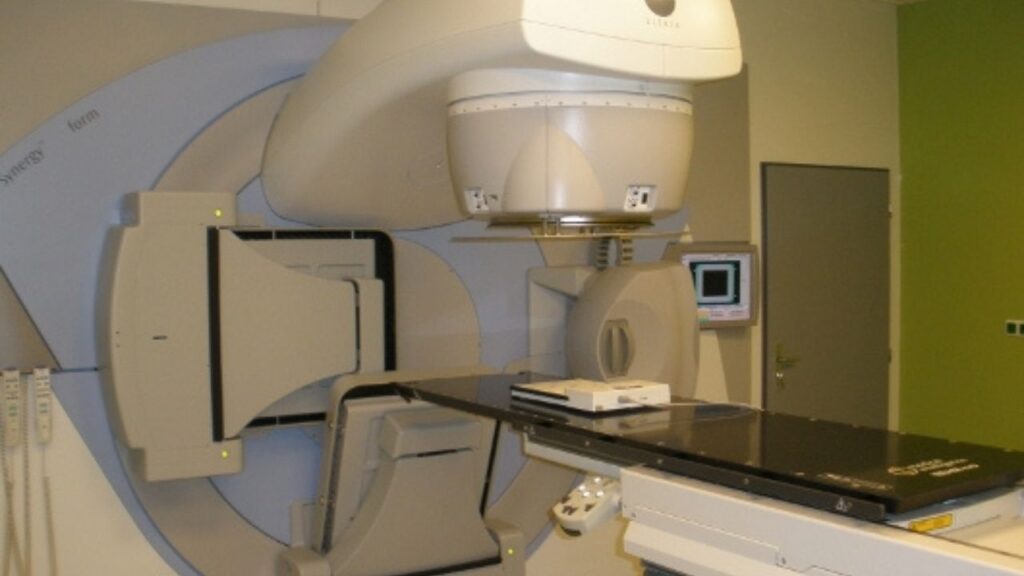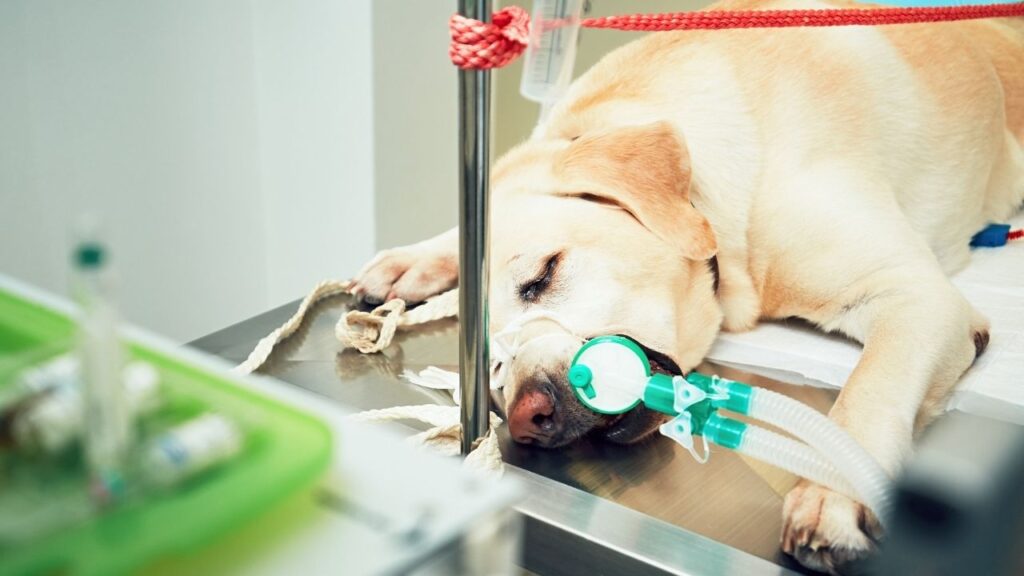Oxygen for dogs is used every day in veterinary hospitals to keep patients breathing normally during surgery and to support dogs who can’t breathe, or are in shock. Hyperbaric oxygen therapy is sometimes used to help chemo be more effective.
Key Takeaways
- Oxygen therapy is good for dogs who are unable to bring in enough oxygen on their own.
- Dogs can be on oxygen for minutes to hours depending on what treatments they are receiving. Long-term use of supplemental oxygen is not practical and can irritate the respiratory tract.
- Dogs are usually given oxygen through a tube in their nose or throat, via a mask, or in a sealed cage.
- Signs that your dog may need more oxygen include shortness of breath, rapid or open-mouthed breathing, rapid heart rate, exercise intolerance, pale or blue mucous membranes, and collapse.
- You can give your dog oxygen at home with some equipment and guidance from your veterinarian.
- The disadvantages of oxygen therapy for dogs are that it is impractical for long-term use and does not address the underlying cause of hypoxia without other testing and treatments.
- Yes, vets can give dogs oxygen!
Oxygen is Critical for Dogs
A breath of fresh air can feel so good. Blood pressure decreases, heart rate becomes less rapid, serotonin rises, and the body feels calmer. Oxygen is needed to provide nutrition to the cells of the body, and may be the most important necessity for a living being. We simply cannot live without it, nor can our dogs.
There are many conditions that can hinder your dog’s ability to get oxygen. This state of reduced oxygen is called hypoxia. When hypoxic conditions occur, it is necessary for oxygen to be supplemented immediately for survival.
Hypoxia can be caused by:
- Pneumonia
- Heart disease
- Trauma
- Asthma
- Anemia
- Cancer
A mass (tumor) in the nose, throat, or lungs can obstruct your dog’s respiratory tract and prevent her from being able to oxygenate. Red blood cells carry oxygen from the lungs to every cell in the body, so problems in the blood can also cause low oxygen levels. Causes of hypoxia (low oxygen) related to the blood include anemia caused by cancer in the bone marrow, a bleeding mass, and side effects from some chemotherapy.
Thankfully, there are several ways that your dog’s veterinary team can quickly provide oxygen to prevent or slow tissue damage.
Supplemental Oxygen Therapy for Dogs
In a veterinary hospital setting, many options exist for providing supplemental oxygen to a hypoxic patient. The veterinarian’s goal is to supplement oxygen until the patient is able to maintain normal oxygen levels on his or her own.
Here are several ways that dogs can be given supplemental oxygen:
- Oxygen cage: This airtight cage is considered the most effective method of administering oxygen to a stressed or fragile patient. It provides increased concentrations of oxygen with the least amount of direct handling by the veterinary team. Patients typically tolerate this very well. Unfortunately, not all veterinary facilities have oxygen cages (though it is sometimes possible to improvise one), and large dogs may not fit. This can also be a bit more expensive as it uses up a lot of oxygen.
- Oxygen collar: An improvised delivery chamber is created by fitting the dog with a cone/Elizabethan collar that is partially covered with cellophane wrap. Carbon dioxide and humidity are allowed to escape from the top. A tube carries oxygen directly into the space within the cone to improve oxygenation of the patient. This is an option for pets that are too large for an oxygen cage.
- Flow-by oxygen: Oxygen flows from a tube into the general vicinity of the dog’s nose. This method causes minimal stress. An oxygen mask can also be placed over the dog’s muzzle as a means of administering oxygen.
- Nasal catheter: Oxygen is administered through a small rubber feeding tube that is passed into the dog’s nose and is either glued or sutured to the skin adjacent to the nose and on top of the head. Some patients will need mild sedation to tolerate tube placement.
- Nasal Prong: A small rubber piece is inserted at the openings of the nose and connected to a breathing tube to provide oxygen.
The patient’s tolerance, availability of resources, and costs are all factors in determining which route is chosen for oxygen therapy in any given situation.
When Dog Oxygen Therapy Is Recommended
Supplemental oxygen therapy is recommended anytime that a patient is hypoxic and not getting enough oxygen. Hypoxia is an emergency and needs to be addressed immediately!
Signs of possible hypoxia include:
- Shortness of breath
- Rapid or open-mouthed breathing
- Rapid heart rate (tachycardia)
- Exercise intolerance
- Discoloration of mucous membranes (often pale or blue)
- Collapse
Oxygen levels are easily measured with a device called a pulse oximeter, which pretty much every veterinary facility has. A pet is considered hypoxic if their oxygen saturation is below 95%.1
The need for oxygen supplementation can also be determined by measuring blood gases. Arterial pO2 (partial pressure of oxygen) is the gold standard used to determine the need for oxygen supplementation, but getting this reading requires special equipment and access to an artery.
How Oxygen Therapy is Used for Dog Cancer
Supplemental oxygen therapy is most often thought of as a therapy used in a critical care setting; however, oncology patients benefit from it too.
Oxygen therapy is provided to sedated or anesthetized animals during imaging done for staging, sample collection, surgery, or radiation therapy. Pre-oxygenating a patient before inducing anesthesia prevents desaturation of the oxygen in the blood and decreases the risk of hypoxia.
If your dog with cancer has anemia, oxygen therapy can support them until the anemia is addressed.
Hyperbaric Oxygen Therapy for Dogs with Cancer
In recent years, the use of hyperbaric oxygen therapy (HBOT) has been explored as a tool to improve outcomes in pets with cancer.
HBOT involves high concentrations of oxygen administered in a pressurized hyperbaric chamber. This therapy is believed to potentially:
- Enhance chemotherapeutic agents
- Lessen tumor burden when used in addition to radiation therapy
- Relieve pain
- Promote wound healing
Definitive treatment protocols have not been clearly established yet since this is a newer modality used for cancer patients. However, research is ongoing worldwide.
How to Get the Best Results
Supplemental oxygen is most effective in a hospital setting until the underlying cause of hypoxia or low oxygen is addressed or prevented. There is nothing extra that you need to do to help your dog benefit from this therapy.
Home Care After Dog Oxygen Therapy
No additional care is needed at home after a pet receives supplemental or hyperbaric oxygen therapy.
Follow Up
Follow-up recommendations will vary greatly depending on the underlying condition that caused your dog to have insufficient oxygen. Your dog’s veterinary team will always strive to be sure his oxygen levels have stabilized before he goes home.
Oxygen therapy itself does not require any follow-up care, though dogs that had a nasal catheter placed or were intubated may show some signs of mild nose or throat irritation.
When to Not Use Oxygen Therapy for Dogs
Oxygen is necessary for living cells, and there are no contraindications for short-term oxygen supplementation.
That said, long-term therapy with high concentrations of oxygen frequently causes inflammation or irritation of the respiratory tract. Lungs are not meant to breathe 100% oxygen for extended periods – the room air we typically breathe is composed of 21% oxygen.
If your dog is unable to get enough oxygen into his body for normal life, he must be examined to figure out what is causing the problem and then treated accordingly.
Where to Get Dog Oxygen Therapy
Oxygen supplementation can be provided in most clinical practice settings. If oxygen therapy needs to be provided at home for additional support, rescue oxygen supplementation kits can be purchased online or with the help of your veterinarian.
An increasing number of facilities provide hyperbaric oxygen therapy. These can be found at: https://www.vhavet.org/chamber-locations.
Safety and Side Effects
Supplemental oxygen therapy is both safe and effective when used appropriately. Since the goal for treatment is short term use, there are usually no side effects.
Cost of Oxygen Therapy for Dogs
The cost of treatment is going to be determined by location, oxygen supply, the route of administration, and the length of time that it is administered. These costs will likely be discussed at the time of administration by your veterinary team.
Topics
Did You Find This Helpful? Share It with Your Pack!
Use the buttons to share what you learned on social media, download a PDF, print this out, or email it to your veterinarian.



